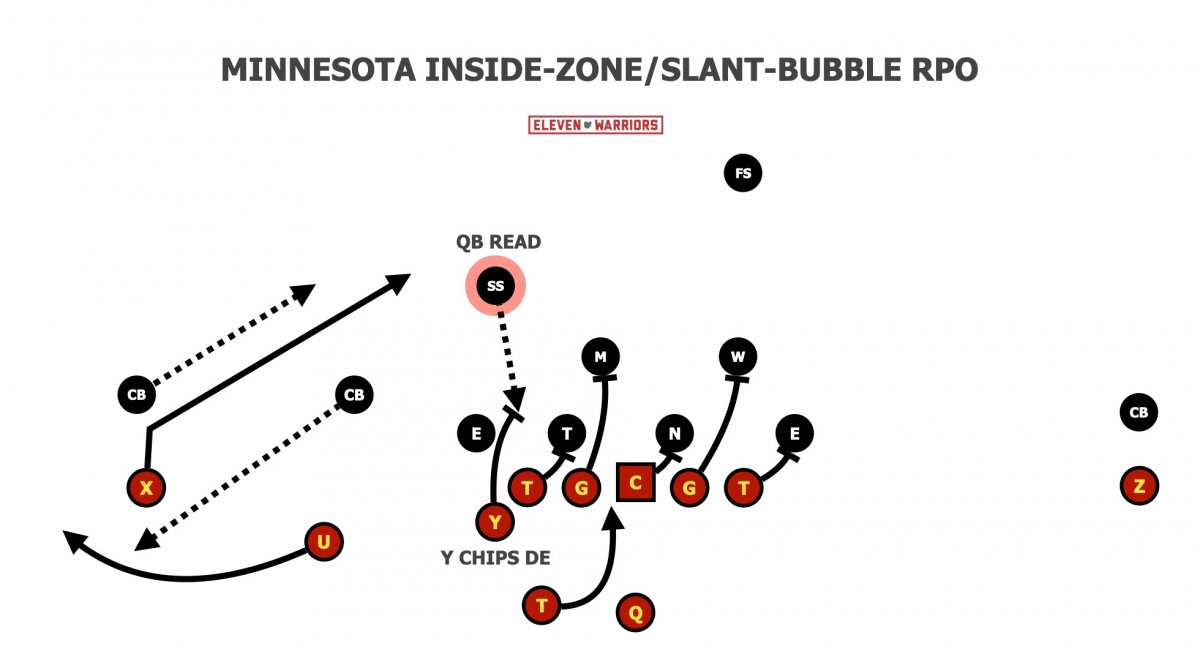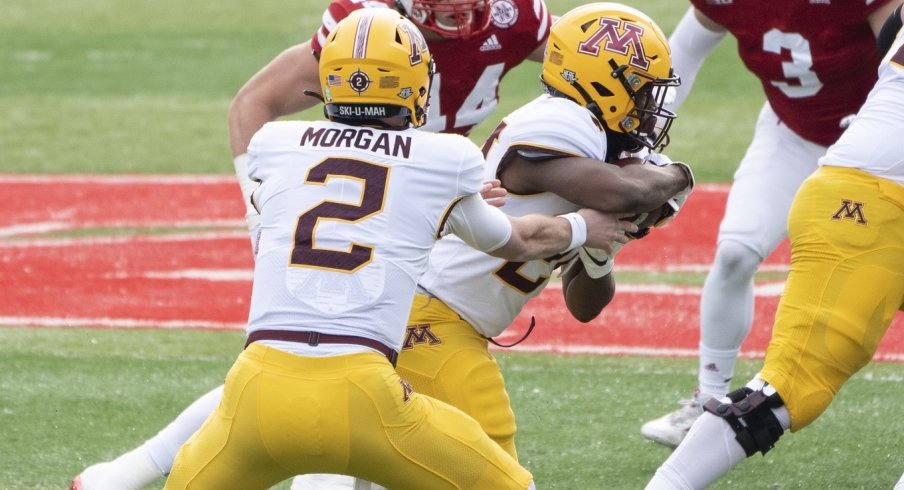For nine months, I've been looking forward to seeing what Kerry Coombs might do with a defense of his own. We've heard about the 4-2-5 personnel, the debut of the Bullet position, and the expectation of a diversified pass defense.
Now, however, just days away from the Buckeyes' first game of the 2021 season, it's readily apparent that all of those expectations should be put on hold for at least another week.
| Pos | Name | # | Wt | Wt |
|---|---|---|---|---|
| LT | Sam Schlueter | 70 | 6'6" | 325 lbs |
| LG | Blais Andries | 77 | 6'6" | 335 lbs |
| C | John Michael Schmitz | 60 | 6'4" | 320 lbs |
| RG | Conner Olson | 64 | 6'5" | 310 lbs |
| RT | Daniel Faalele | 78 | 6'9" | 380 lbs |
| TE | Ko Keift | 42 | 6'5" | 265 lbs |
| TE | Brevyn Spann-Ford | 88 | 6'7" | 270 lbs |
Coombs and co. are counting down the hours before they board a plane to the Twin Cities, wherein they'll face off with one of the biggest and most physical offenses in the country. It's not just massive right tackle Daniel Faalele anchoring the right side of the Minnesota line, as the rest of the Golden Gophers feature plenty of size - and that includes a stable of humungous tight ends as well.
Though P.J. Fleck has not yet lived up to the expectations he himself set for the program since he arrived in 2017, this style of offense has quietly become the program's trademark. The Gophers don't mask what they're trying to do - they're going to run the ball behind zone blocking and throw off those same looks once the defense gets out of position as a result.
For all the focus on the size of the Minnesota O-line, it doesn't just get by on pushing people around. Given that the Gophers rely heavily on zone schemes, they must effectively work together on combination blocks, as we see from the left side below.
As the left guard takes a lateral step to his right, he quickly punches the inside shoulder of the defensive lineman to his left before coming off to block the middle linebacker. That punch holds up the defender just long enough for the left tackle to get under that defender and cut him off, creating a seam for the Big Ten's reigning rushing leader, Mohamed Ibrahim.
It is hard to see on TV, but the Gopher OL takes relatively tight splits between each other, with the guards only a foot apart from the center (instead of the normal two), and the tackles just two feet outside the guards (instead of three). By starting closer together, it's easier for two blockers to get their hands on one defender lining up in the gap between them, as we saw above.
The Gophers will also often line up with six true offensive linemen, using an extra tackle instead of a tight end. In response, defenses are forced to respond in kind by packing the box with extra defenders, such as this 5-3 look seen from Wisconsin.
Though the defense was able to stop this split-zone run by simply creating a pile where the running back's lane was supposed to be, the Minnesota offense is betting that speed-rushing ends won't be willing to do that all game long. Additionally, the Gophers actually want to see defenses packing the line of scrimmage like this, as it opens up the RPO game outside.

Senior QB Taylor Morgan has mastered the art of reading individual defenders, including safeties coming down from the third level. Instead of having just one route to throw to, Fleck's staff will usually give him both a quick, three-step route like a slant or hitch as well as a wide receiver screen (which also helps clear defenders out of the way).
Given how often they call for wide zone runs that ask the line to move laterally, the Gophers also incorporate a heavy amount of play-action passes off that same movement. With the line moving horizontally in one direction, it pulls the linebackers and safeties out of position without risk of an illegal man downfield penalty, all while giving Morgan plenty of time and space to find crossing receivers as he rolls the other way.
This physical, layered play-calling scheme often results in one of the Big Ten's most efficient offenses. Although teams often know what's coming, they're powerless to stop it - much like facing a service academy's triple-option scheme.
The Gophers may not be explosive, save the occasional run from Ibrahim that gets into the secondary, but they're more than capable of staying on the field for long, exhausting drives. Only Ohio State had a better conversion rate on third downs last fall in the Big Ten, as the Gophers were regularly in manageable situations where they weren't forced to simply drop back and pass downfield.
As a result, the best way to slow the Gopher offense is to win on first and second downs, creating negative plays that keep the offense 'behind schedule.'
Luckily, the Buckeyes feature a dynamic defensive front that is capable of shooting gaps and making plays in the backfield, meaning they shouldn't have to send a blitz to create penetration. There is, of course, a downside to this approach, as there is not one linebacker on the entire roster with starting experience, and those linebackers will be the ones forced with cleaning up if the defensive line doesn't make a play in the backfield.
Additionally, the strength of the OSU defensive line comes on the edges. Although Haskell Garrett may be an All-American inside, the Gophers like to run the ball by double-teaming interior players like him, as we've seen. Not only will he and Taron Vincent need to make plays from their tackle spots when in the game, but players like Antwaun Jackson and Jerron Cage must also be able to shoot gaps inside and re-route Ibrahim in the backfield.
While Morgan is a veteran signal-caller capable of making plays from the pocket, it's hardly the Gophers' strength. That massive offensive line is much more comfortable moving forward while run-blocking than dropping into a pass set against the speed rushers the Buckeyes will bring to Minneapolis.
But in order for fans to see the new 'Rushmen' package lining up on third downs, Coombs' defense must force that situation first. Playing gap-sound run defense on first and second downs with three (or even four) linebackers in the game is likely the best way to do so.
For those looking forward to seeing the likes of Lathan Ransom or Craig Young making plays in the secondary, however, you may have to wait another week to get your wish.



